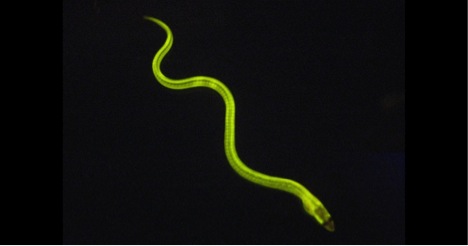Fluorescent proteins have completely revolutionized the way medical and biological science is being done. They have been used to watch broken hearts mend themselves, explain HIV virulence, monitor self-destructing dengue mosquitoes and create bird-flu-resistant chickens. According to Robert Hoffman, professor of surgery at the University of San Diego Medical School, fluorescent protein technology is "the greatest revolution in bio-medical science since the first microscope and the first x-ray." In acknowledgement of the importance of the field, Roger Tsien, Martin Chalfie and Osamu Shimomura were awarded the 100th Nobel Prize in chemistry for "the discovery and development of the Green Fluorescent Protein, GFP."
Crystal jellyfish emit pinpricks of green light. They have roughly 350 photoorgans that produce the light, and it is in these organs that the first fluorescent protein, GFP, was found. Since then, there has been a major effort to find fluorescent proteins in other organisms with successes in over 125 different species. Just this week, a paper in Cell reported finding the first fluorescent protein in vertebrates, as well as its structure and potential uses. This protein was found in a Japanese freshwater eel.

The Japanese freshwater eel, Unagi, gives off green light when illuminated with blue light. It is the first vertebrate found to contain a fluorescent protein. (Image courtesy of RIKEN)
The eel is considered a delicacy in Japan and is on the verge of extinction due to global warming and overconsumption. Although it is a freshwater fish, the mature eel swims thousands of miles to spawn in the Philippine Seas. And then, quite amazingly, over the course of several months, the larvae will swim all the way back to Japan.
In 2009, intrigued by the energy required for these tiny larva to swim thousands of miles, researchers had a closer look at their muscles and discovered that their muscle fibers are fluorescent. Atsushi Miyawaki, a superstar in the fluorescent protein field (he has developed a way to make mouse brains transparent, and a technique for tracking the cell cycle in cell development and cancerous growth) from the RIKEN Brain Science Institute in Wako-city, Japan, read the 2009 paper and was inspired to hunt down the source of the fluorescence in the eel. He was hoping that it was a protein that was responsible for the fluorescence, a protein that could be added to the existing fluorescent protein tool chest.
Miyawaki hit pay dirt: Not only was it a fluorescent protein, but it was a completely new type of fluorescent protein, very different from the GFP-like proteins found in the other 125 species. However, when Miyawaki expressed the protein, UnaG, in bacteria, the protein did not glow; it seemed that there was something in the eels that was required for fluorescence but was not present in bacteria.
The missing ingredient turned out to be bilirubin, which is the yellow breakdown product of old red blood cells. Elavated levels of bilirubin are indicative of liver problems, and the molecule is also responsible for the yellow color seen in bruises or jaundiced individuals. Currently, bilirubin levels are measured using a convoluted and imprecise methods. In this week's Cell paper, Miyawaki and his co-workers have shown that the fluorescent eel protein can be used to measure bilirubin in human serum with an improved sensitivity over existing tests. Fluorescent proteins have been used to light up a myriad of laboratory experiments, but this would be the first clinical use of a fluorescent protein.
"We believe the system is going to revolutionize the clinical measurement of bilirubin in hospitals worldwide and lead to a better understanding of blood and liver metabolism in humans," says Miyawaki. "Before the discovery of UnaG, I couldn't imagine that basic science could have such a direct impact on human health. From a simple eel, we found a new path to the clinic."
